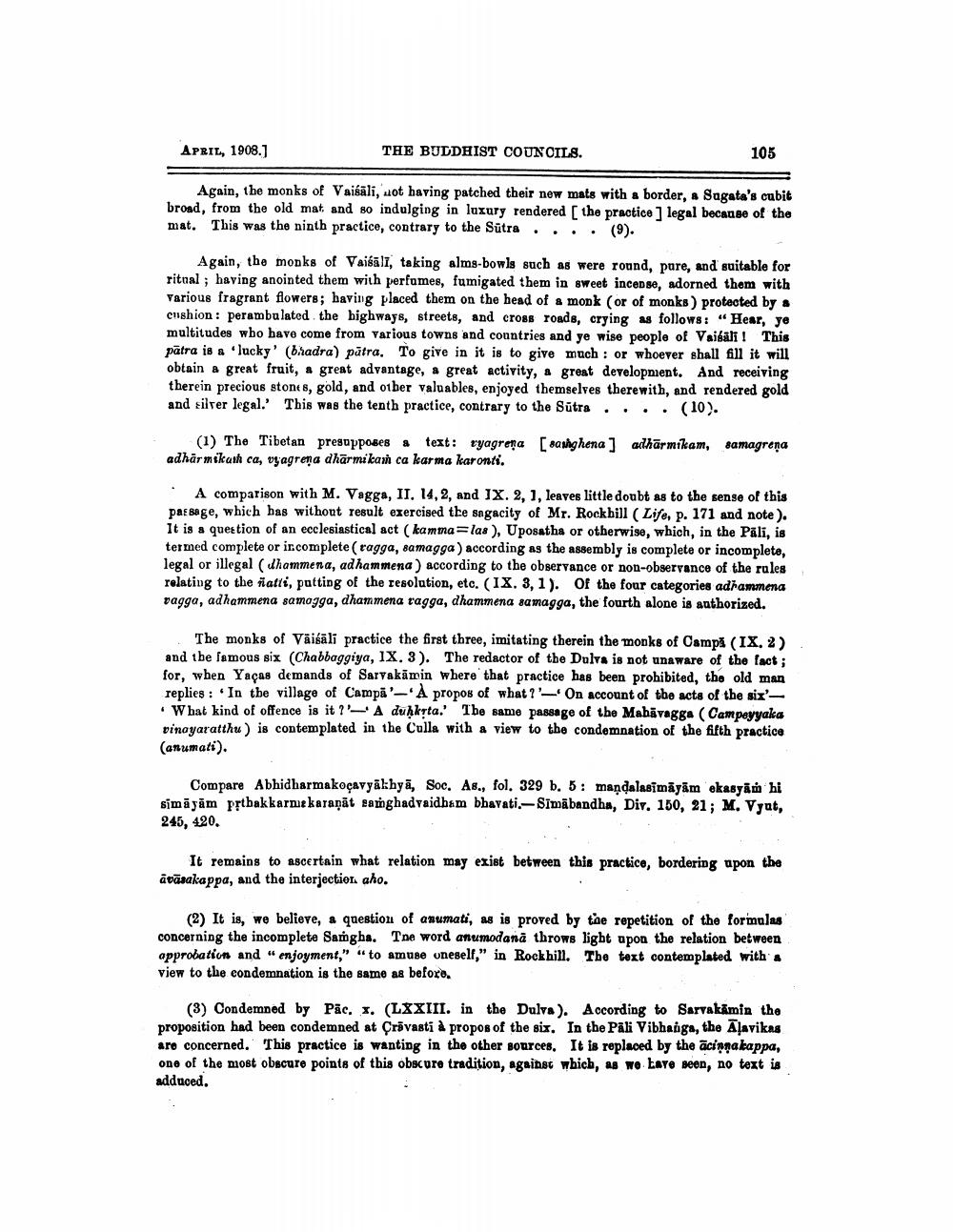________________
APRIL, 1908.]
THE BUDDHIST COUNCILS.
105
Again, the monks of Vaiśāli, not having patched their new mats with a border, Sugata's cubit broad, from the old mat and so indulging in luxury rendered [ the practice ] legal because of the mat. This was the ninth practice, contrary to the Sutra ... (9).
Again, the monks of Vaisāli, taking alms-bowls such as were round, pare, and suitable for ritual; having anointed them with perfumes, fumigated them in sweet incense, adorned them with Various fragrant flowers; having placed them on the head of a monk (or of monks ) protected by a cushion : perambulated the highways, streets, and cross roads, crying as follows: “Hear, ye multitudes who have come from various towns and countries and ye wise people of Vaibali ! This pātra is a lucky' (bradra) pătra. To give in it is to give much : or whoever shall fill it will obtain a great fruit, & great advantage, a great activity, a great development. And receiving therein precious stones, gold, and oiber valuables, enjoyed themselves therewith, and rendered gold and silver legal.' This was the tenth practice, contrary to the Sutra .... (10).
(1) The Tibetan presupposes & text: ryagrena [sannghena ] adhär mikath ca, vyagrena dhārmikan ca karma karonti.
adhārmikam, samagrena
A comparison with M. Vagga, II, 14,2, and IX. 2, 1, leaves little doubt as to the sense of this passage, which has without result exercised the sagacity of Mr. Rockbill ( Life, p. 171 and note ). It is a question of an ecclesiastical act ( kamna=las ), Uposaths or otherwise, which, in the Pali, is termed complete or incomplete (ragga, samagga) according as the assembly is complete or incomplete, legal or illegal (dhammena, ad hammena) according to the observance or non-observance of the rules relating to the fatti, putting of the resolution, etc. (IX. 3, 1). Of the four categories adhammena vagga, adhammena samagga, dhammena tagga, dhammena samagga, the fourth alone is authorized.
The monks of Väikäli practice the first three, imitating therein the monks of Campi (IX, 2) and the famous six (Chabbaggiya, IX. 3). The redactor of the Dulva is not unaware of the fact; for, when Yaças demands of Sarvakāmin where that practice has been prohibited, the old man replies : In the village of Campa'-'À propos of what?' On account of the acts of the six• What kind of offence is it? Y A duḥkyta. The same passage of the Mabävagga (Campoyyaka vinoyaratthu ) is contemplated in the Culla with a view to the condemnation of the fifth practice (antumati).
Compare Abhidharmakoçavyākhyā, Soc. As., fol. 329 b. 5: mandalasimāyām ekasyā hi simiyim prtbakkarniekaranät Parghadvaidbam bhavati.-Simabandha, Div. 150, 21; M. Vyat, 245, 420.
It remains to ascertain what relation may exist between this practice, bordering upon the avāsakappa, and the interjection, aho.
(2) It is, we believe, a question of anumati, as is proved by the repetition of the formulas concerning the incomplete Samgha. The word anumodana throws light upon the relation between approbation and enjoyment," "to amuse oneself," in Rockhill. The text contemplated with a view to the condemnation is the same as before.
(3) Condemned by Pac. x. (LXXIII. in the Dulva). According to Sarvakāmin the proposition had been condemned at Srivasti à propos of the six. In the Pali Vibhanga, the Alavikas are concerned. This practice is wanting in the other sources. It is replaced by the acinnakappa, one of the most obscure points of this obscure tradition, against which, as we have seen, no text is adduced.




